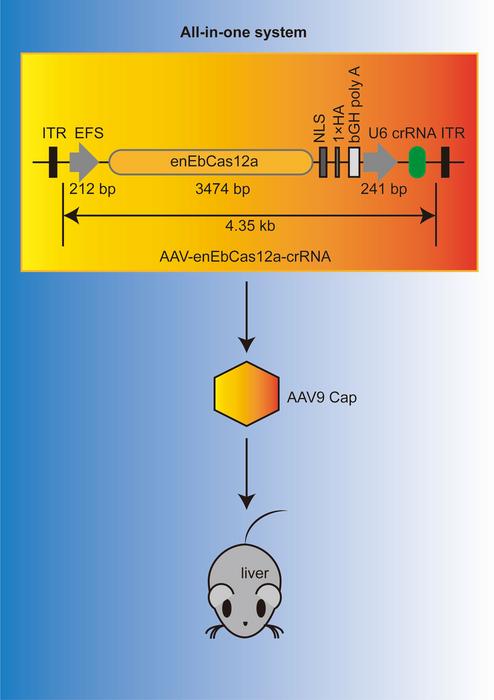Researchers have developed a novel version of a key CRISPR gene-editing protein that shows efficient editing activity and is small enough to be packaged within a non-pathogenic virus that can deliver it to target cells. Hongjian Wang and colleagues at Wuhan University, China, present these findings May 23rd in the open-access journal PLOS Biology.

Credit: Chen Peng (CC-BY 4.0,
Researchers have developed a novel version of a key CRISPR gene-editing protein that shows efficient editing activity and is small enough to be packaged within a non-pathogenic virus that can deliver it to target cells. Hongjian Wang and colleagues at Wuhan University, China, present these findings May 23rd in the open-access journal PLOS Biology.
Recent years have seen an explosion of research attempting to harness CRISPR gene-editing systems—which are found naturally in many bacteria as a defense against viruses—so they can be used as potential treatments for human disease. These systems rely on so-called CRISPR-associated (Cas) proteins, with Cas9 and Cas12a being the two most widely used types, each with their own quirks and strengths.
One promising idea is to package CRISPR proteins within a non-pathogenic virus, which could then deliver the proteins to target cells; there, they would modify specifically targeted DNA sequences to treat disease. However, the commonly used adeno-associated virus is small, and while some Cas9 proteins can fit inside, Cas12a proteins are typically too large.
Now, Wang and colleagues have identified a relatively small version of Cas12a, termed EbCas12a, that occurs naturally in a species of the Erysipelotrichia class of bacteria. By deliberately switching out one of the amino acid building blocks of the protein for another, they boosted its gene-editing efficiency. When applied to mammalian cells in a dish in the lab, this modified protein—dubbed enEbCas12a—shows gene-editing efficiency comparable to that of two other Cas12a proteins known for highly accurate gene editing.
The research team then demonstrated that enEbCas12a is small enough to be used for adeno-associated virus-based gene therapy. They modified enEbCas12a to target a specific cholesterol-associated gene, packaged it within the virus, and administered the virus to mice with high cholesterol. One month later, they found a significant reduction of blood cholesterol levels in the treated mice, compared to mice that did not receive the virus.
More research will be needed to determine if enEbCas12a could one day be used to address human disease. Nonetheless, these findings suggest it could be possible to use adeno-associated virus to deliver Cas12a proteins for gene therapy.
The authors add, “The novel compact enEbCas12a, along with its crRNA, can be packaged into an all-in-one AAV system for convenient gene editing in vitro and in vivo with high-fidelity, which can be very beneficial for future clinical applications and more tool developments including all-in-one AAV- based multi-gene editing, base editing, primer editing, etc.”
#####
In your coverage, please use this URL to provide access to the freely available paper in PLOS Biology:
Citation: Wang H, Zhou J, Lei J, Mo G, Wu Y, Liu H, et al. (2024) Engineering of a compact, high-fidelity EbCas12a variant that can be packaged with its crRNA into an all-in-one AAV vector delivery system. PLoS Biol 22(5): e3002619.
Author Countries: China
Funding: This work was supported by the National Key R&D Program of China (2022YFA1303500 to LY), the National Natural Science Foundation of China (32101196 to PC, 32171210, 31870728 and 32371271 to LY), the Fundamental Research Funds for the Central Universities (2042022kf1189 to LY), the China Postdoctoral Science Foundation (2021TQ0253 and 2022M712468 to PC, 2022M722473 to JZ). The funders had no role in study design, data collection and analysis, decision to publish, or preparation of the manuscript.
Journal
PLoS Biology
Method of Research
Experimental study
Subject of Research
Animals
COI Statement
Competing interests: The authors have declared that no competing interests exist.



